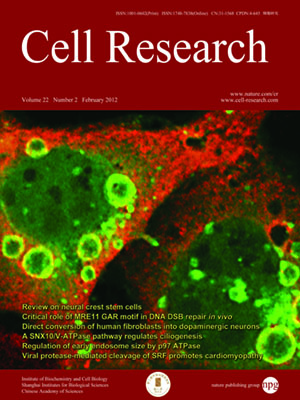
Volume 22, No 2, Feb 2012
ISSN: 1001-0602
EISSN: 1748-7838 2018
impact factor 17.848*
(Clarivate Analytics, 2019)
Volume 22 Issue 2, February 2012: 305-320
ORIGINAL ARTICLES
The MRE11 GAR motif regulates DNA double-strand break processing and ATR activation
Zhenbao Yu1, Gillian Vogel1, Yan Coulombe2, Danielle Dubeau1, Elizabeth Spehalski3, Josée Hébert4,5, David O Ferguson3, Jean Yves Masson2 and St閜han
1Terry Fox Molecular Oncology Group, Bloomfield Center for Research on Aging, Lady Davis Institute for Medical Research, Sir Mortimer B. Davis Jewish General Hospital, and Departments of Oncology and Medicine, McGill University, Montreal, Quebec, Canada H3T 1E2
2Genome Stability Laboratory, Laval University Cancer Research Center, H魌el-Dieu de Qu閎ec (CHUQ), Quebec city, Quebec, Canada G1R 2J6
3Department of Pathology, University of Michigan Medical School, Ann Arbor, MI 48109, USA
4Leukemia Cell Bank of Quebec, and Division of Hematology, Maisonneuve-Rosemont Hospital, Montreal, Quebec, Canada
5Department of Medicine, Universit?de Montr閍l, Montreal, Quebec, Canada H1T 2M4
Correspondence: Stéphane Richard,(stephane.richard@mcgill.ca)
The MRE11/RAD50/NBS1 complex is the primary sensor rapidly recruited to DNA double-strand breaks (DSBs). MRE11 is known to be arginine methylated by PRMT1 within its glycine-arginine-rich (GAR) motif. In this study, we report a mouse knock-in allele of
Mre11 that substitutes the arginines with lysines in the GAR motif and generates the MRE11
RK protein devoid of methylated arginines. The
Mre11RK/RK mice were hypersensitive to
γ-irradiation (IR) and the cells from these mice displayed cell cycle checkpoint defects and chromosome instability. Moreover, the
Mre11RK/RK MEFs exhibited ATR/CHK1 signaling defects and impairment in the recruitment of RPA and RAD51 to the damaged sites. The M
RKRN complex formed and localized to the sites of DNA damage and normally activated the ATM pathway in response to IR. The M
RKRN complex exhibited exonuclease and DNA-binding defects
in vitro responsible for the impaired DNA end resection and ATR activation observed
in vivo in response to IR. Our findings provide genetic evidence for the critical role of the MRE11 GAR motif in DSB repair, and demonstrate a mechanistic link between post-translational modifications at the MRE11 GAR motif and DSB processing, as well as the ATR/CHK1 checkpoint signaling.
Cell Research (2012) 22:305-320. doi:10.1038/cr.2011.128; published online 9 August 2011
FULL TEXT | PDF
Browse 1979


